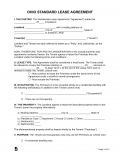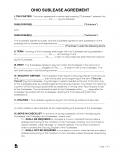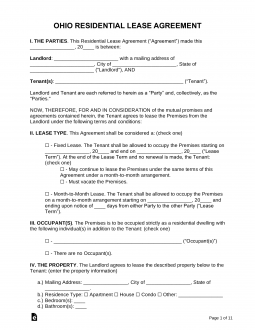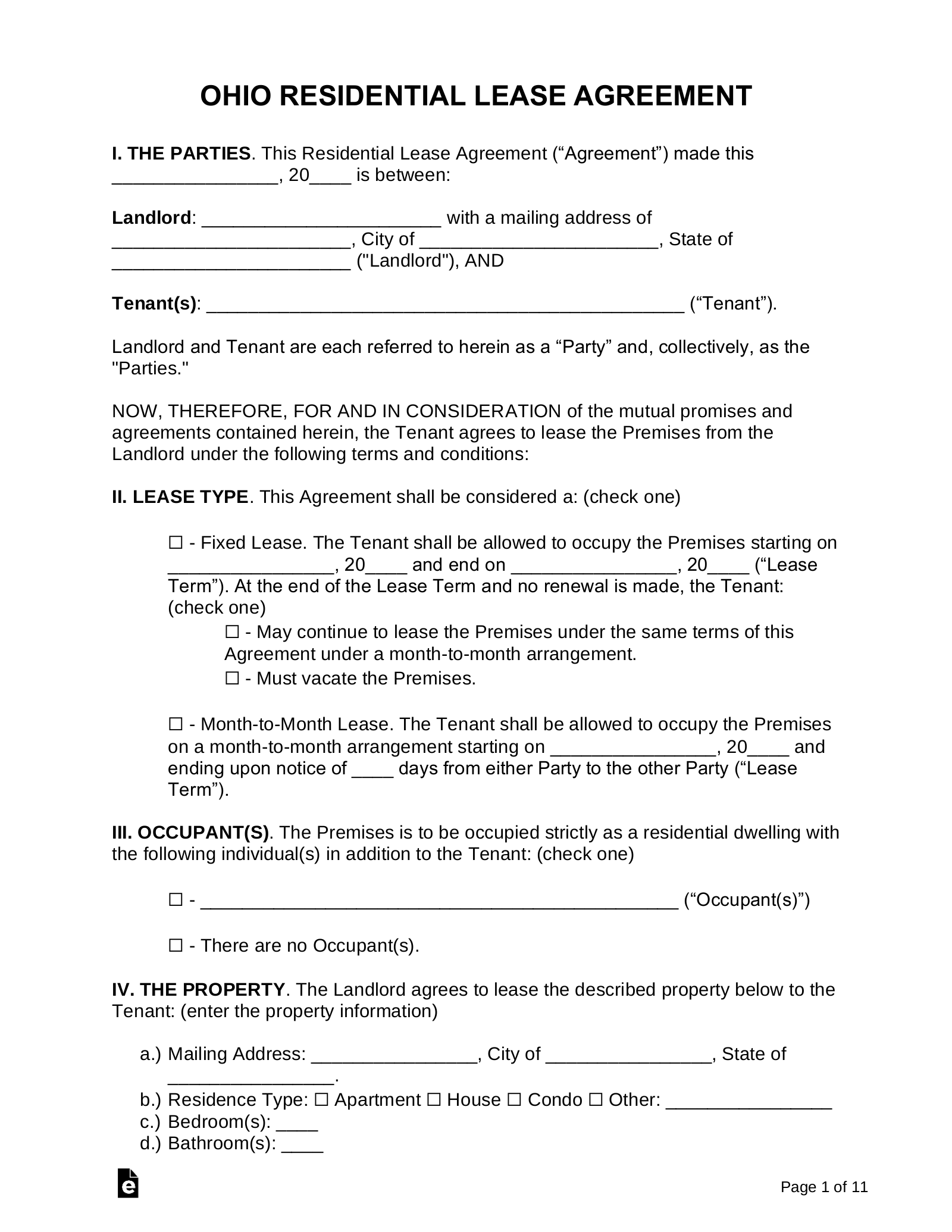Updated February 09, 2024
An Ohio lease agreement is a legal contract written for a landlord seeking to rent residential or commercial property to a tenant. Before authorizing, the tenant will view the property and negotiate the rent and the landlord’s responsibilities. After a verbal agreement is made, a rental application will be completed to verify the tenant’s income. Once all the tenant’s credentials are approved, a written lease will be signed.
Table of Contents |
Agreement Types (6)
 Standard Residential Lease Agreement – Fixed-term that usually lasts for 12 months but can be for any specific timeframe as agreed upon by the landlord and tenant. Standard Residential Lease Agreement – Fixed-term that usually lasts for 12 months but can be for any specific timeframe as agreed upon by the landlord and tenant.
Download: PDF, MS Word, OpenDocument |
 Commercial Lease Agreement – A contract written for the use of business-related space such as office, retail, or industrial. Commercial Lease Agreement – A contract written for the use of business-related space such as office, retail, or industrial.
Download: PDF, MS Word, OpenDocument |
 Month-to-Month Lease Agreement – A contract with no end date. The landlord and tenant may have an ongoing arrangement where payment is made every month. Either party may terminate the contract with at least 30 days’ written notice. Month-to-Month Lease Agreement – A contract with no end date. The landlord and tenant may have an ongoing arrangement where payment is made every month. Either party may terminate the contract with at least 30 days’ written notice.
Download: PDF, MS Word, OpenDocument |
 Rent-to-Own Lease Agreement – A residential fixed-term document with an added benefit to the tenant of being able to buy the property at a specific price. Rent-to-Own Lease Agreement – A residential fixed-term document with an added benefit to the tenant of being able to buy the property at a specific price.
Download: PDF, MS Word, OpenDocument |
 Room Rental (Roommate) Agreement – Created for individuals sharing a home where each person shall occupy a bedroom and share the main or common areas. The form shall state the roles of each person and the amount which they have to pay for utilities, expenses, etc. Room Rental (Roommate) Agreement – Created for individuals sharing a home where each person shall occupy a bedroom and share the main or common areas. The form shall state the roles of each person and the amount which they have to pay for utilities, expenses, etc.
Download: PDF |
 Sublease Agreement – Between the tenant and subtenant, who would continue the original tenant’s lease with the landlord’s permission. The subtenant must adhere to all the terms and conditions in the master agreement. Sublease Agreement – Between the tenant and subtenant, who would continue the original tenant’s lease with the landlord’s permission. The subtenant must adhere to all the terms and conditions in the master agreement.
Download: PDF, MS Word, OpenDocument |
Required Disclosures (1)
- Lead-Based Paint Disclosure – Federal law requires all landlords, managers, and agents overseeing buildings constructed prior to 1978 to inform their tenants of the possible existence of this type of paint.
Security Deposits
Maximum Amount – Ohio state law does not establish a maximum amount that a landlord can charge for a security deposit.
Collecting Interest – If the security deposit is greater than either $50 or the equivalent of one month’s rent, whichever is greater, and the lease is at least six months, the landlord must place the funds in an interest-bearing account with a 5% annual rate.[1]
Returning – Within 30 days of the end of tenancy, the landlord must return the security deposit to the tenant, minus any withheld amounts.[2]
- Itemized List – If the landlord applies any portion of the security deposit to the cost of damages or unpaid rent, they must itemize and identify these deductions in a written notice to the tenant within 30 days of the end of tenancy.[2]
When is Rent Due?
Grace Period – There is no statutory grace period in Ohio; rent is due on the date mentioned in the lease. If rent is not paid on the due date, the landlord can start the eviction process by sending the tenant a three-day notice to quit.[3]
Maximum Late Fee – There is no state law establishing a maximum fee for the late payment of rent. However, any such penalty should be reasonably proportionate to the rent.
NSF Fee – If the tenant writes a bad check, the landlord can charge a maximum of $30 or 10% of the check amount, whichever is greater.[4]
Withholding Rent – If the landlord has failed to fulfill their obligations to maintain the property in a way that materially affects health and safety, then the tenant, after giving reasonable notice, may deposit their rent with the county or municipal court clerk.[5]
Right to Enter (Landlord)
Standard Access – The landlord must give 24 hours’ notice before entering the property for maintenance or other ordinary reasons.[6]
Immediate Access – The landlord is not required to give notice before entering in the case of an emergency or if it is impracticable to do so.[6]
Abandonment
Absence – Ohio state law does not establish a specific length of time that a tenant must be absent from the premises for a rental property to be considered abandoned.
Breaking the Lease – If the landlord has been given 30 days’ notice of their failure to maintain the property in compliance with applicable housing and building codes, then the tenant may terminate the lease without penalty.[7]
Tenant’s Utility Shutoff – If the tenant’s failure to keep essential utilities amounts to a violation of their obligations affecting health and safety, then the landlord may deliver a 30-day notice to vacate or to address the violation.[8]
Unclaimed Property – No statewide statute establishes what a landlord is legally required to do with abandoned personal property after a tenant has vacated a rental unit.


